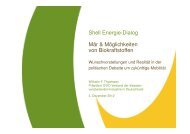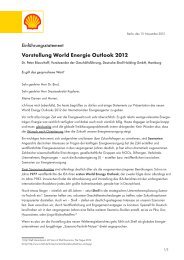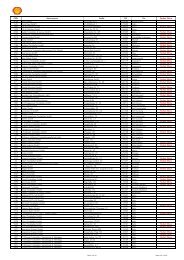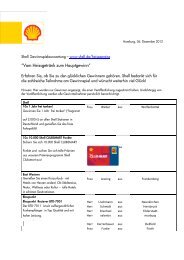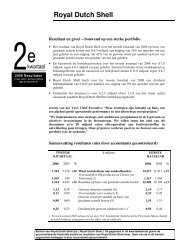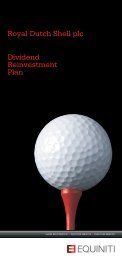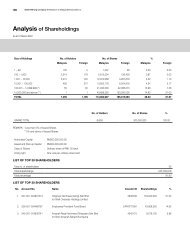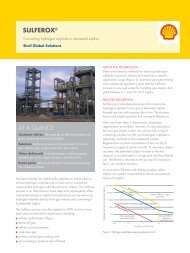ASCENTTM DC-2534: Performance that Delivers Greater Value for ...
ASCENTTM DC-2534: Performance that Delivers Greater Value for ...
ASCENTTM DC-2534: Performance that Delivers Greater Value for ...
Create successful ePaper yourself
Turn your PDF publications into a flip-book with our unique Google optimized e-Paper software.
ASCENT TM <strong>DC</strong>-<strong>2534</strong>: <strong>Per<strong>for</strong>mance</strong> <strong>that</strong><br />
<strong>Delivers</strong> <strong>Greater</strong> <strong>Value</strong> <strong>for</strong> Your Investment<br />
ASCENT catalysts <strong>for</strong> ultra-low-sulphur-diesel (ULSD) production<br />
Refiners who are planning to replace their ULSD catalysts have<br />
important decisions to make. The factors they must consider<br />
include catalyst per<strong>for</strong>mance, hydrogen consumption and catalyst<br />
regeneration/reuse options, all of which will have a direct bearing<br />
on their costs and the economic value of their operations. Optimising<br />
reactor fill cost and evaluating catalyst life-cycle economics can be<br />
complex and will depend on each refiner’s situation.<br />
Building on the ASCENT technologies’ successes in distillates<br />
and FCC and hydrocracking pretreatment, Criterion Catalysts<br />
& Technologies (Criterion) has developed ASCENT <strong>DC</strong>-<strong>2534</strong>,<br />
a new cobalt–molybdenum (CoMo) ULSD catalyst <strong>for</strong> top-tier<br />
desulphurisation per<strong>for</strong>mance in the low-to-medium pressure range.<br />
This flexible catalyst solution is designed <strong>for</strong> refiners <strong>that</strong> want to<br />
maximise diesel production while managing hydrogen consumption<br />
and operating costs (Table 1).<br />
Table 1: The benefits of ASCENT <strong>DC</strong>-<strong>2534</strong> at a glance<br />
Customer requirement Benefits of ASCENT <strong>DC</strong>-<strong>2534</strong><br />
Highest activity CoMo at<br />
low-to-medium pressures<br />
■ Longer runs<br />
Lower density ■ Reduced fill cost<br />
Excellent hydrodesulphurisation<br />
selectivity (minimum H 2<br />
consumption)<br />
■ Process heavier and harder feeds<br />
■ Easier transition to full-time Euro V diesel<br />
■ Reduce hydrogen operating costs and<br />
product giveaway<br />
Stable start-of-run activity ■ No hyperactivity or excessive<br />
hydrogen consumption<br />
Regenerable by conventional<br />
methods<br />
■ Improved multi-cycle economics<br />
High strength ■ Good regeneration yields, multi-cycle<br />
economics<br />
Normal sulphiding procedures ■ No long holds at intermediate<br />
temperatures, as required <strong>for</strong> some<br />
Type II activations<br />
Handling and loading flexibility ■ No special packaging is required<br />
■ Reactor loading is easily handled in air<br />
Flexible delivery <strong>for</strong>m ■ Can be sulphided in situ or ex situ<br />
As with the other catalysts in the ASCENT range, <strong>DC</strong>-<strong>2534</strong><br />
offers multi-cycle cost benefits, which are made possible through<br />
conventional regeneration and strong physical properties.<br />
Figure 1 shows where <strong>DC</strong>-<strong>2534</strong> fits in the ASCENT ULSD catalyst<br />
portfolio with reference to the unit’s constraints on pressure, hydrogen,<br />
feed severity and desired level of per<strong>for</strong>mance. Criterion can<br />
customise an ASCENT solution <strong>for</strong> your specific needs.<br />
Feed difficulty/severity, catalyst per<strong>for</strong>mance<br />
CoMo<br />
<strong>DC</strong>-<strong>2534</strong><br />
<strong>DC</strong>-2532<br />
ASCENT<br />
customcatalystdesigned<br />
system<br />
NiMo<br />
Hydrogenation environment, H 2 consumption<br />
Figure 1: <strong>DC</strong>-<strong>2534</strong>’s place in the ASCent ULSD catalyst portfolio.<br />
DN-3531
The technology behind ASCENT catalysts<br />
When developing ASCENT <strong>DC</strong>-<strong>2534</strong>, Criterion applied enhanced<br />
experimentation techniques to study a range of catalyst <strong>for</strong>mulations.<br />
This enabled Criterion to optimise promoter metal utilisation through<br />
an improved catalyst physical structure. This approach has increased<br />
the number of active sites in <strong>DC</strong>-<strong>2534</strong> when compared with<br />
previous generations of ASCENT catalyst.<br />
By delivering a balance of Type I and Type II active sites, <strong>DC</strong>-<strong>2534</strong><br />
provides reaction pathways <strong>for</strong> direct and indirect desulphurisation. The<br />
balance of site types, combined with a higher number of active sites,<br />
is very effective at low-to-medium operating pressures. Consequently,<br />
<strong>DC</strong>-<strong>2534</strong> provides stability throughout the run by preventing<br />
hyperactivity or excessive hydrogen consumption at the start of run and<br />
providing desulphurisation in the poor hydrogenation environments<br />
found at end-of-run conditions where indirect desulphurisation is difficult.<br />
The mix of active sites also improves the selectivity <strong>for</strong> sulphur removal<br />
over aromatics saturation when compared with Type II catalysts. This<br />
results in lower hydrogen consumption through reduced polynuclear<br />
aromatics saturation (Figure 2).<br />
Range of relative hydogen consumption, %<br />
25<br />
, % 20<br />
15<br />
10<br />
5<br />
0<br />
ASCENT<br />
<strong>DC</strong>-<strong>2534</strong><br />
Type II<br />
CoMo<br />
Type I<br />
NiMo<br />
Figure 2: ASCENT <strong>DC</strong>-<strong>2534</strong> delivers the lowest possible hydrogen consumption <strong>for</strong><br />
ULSD production.<br />
minimises overALL<br />
caTalysT life-cycle cosTs<br />
Type II<br />
NiMo<br />
The strong physical characteristics of ASCENT <strong>DC</strong>-<strong>2534</strong> reduce<br />
the risk of pressure-drop problems and catalyst losses during<br />
regeneration and reuse. The catalyst is supplied in the oxide state or<br />
presulphided, and is easily regenerated using standard processes.<br />
<strong>DC</strong>-<strong>2534</strong> is the preferred ULSD catalyst <strong>for</strong> distillate hydrotreaters<br />
<strong>that</strong> operate at low-to-medium operating pressures owing to its<br />
balanced Type I and Type II active site structure. This feature also<br />
provides the same selectivity as previous generations of ASCENT<br />
catalysts <strong>for</strong> sulphur removal over aromatics saturation, which<br />
makes it an ideal catalyst to use when hydrogen supply is limited<br />
(Figure 2).
How can you benefit from ASCENT catalysts?<br />
The ASCENT range reduces overall catalyst life-cycle costs, as it<br />
requires simple regeneration rather than the more costly rejuvenation<br />
option. The fill costs <strong>for</strong> ASCENT and Type II catalysts may be<br />
comparable <strong>for</strong> the first fill, but with <strong>DC</strong>-<strong>2534</strong> greater than 90% of the<br />
fresh activity is recovered through conventional regeneration. This means<br />
<strong>that</strong> a larger proportion of the catalyst can be retained in the second<br />
cycle fill. Using <strong>DC</strong>-<strong>2534</strong> helps refiners to minimise the costs associated<br />
with purchase of fresh catalyst. In subsequent cycles, the result (see<br />
Table 2) is a saving of up to 15% of the total two-cycle costs.<br />
ASCENT <strong>DC</strong>-<strong>2534</strong> can be used as a full or partial fill in many<br />
distillate hydrotreaters to help increase sulphur removal, extend run<br />
length, expand capacity and/or upgrade more low-value feeds. The<br />
catalyst delivers an excellent per<strong>for</strong>mance advantage over a wide<br />
range of feed types (Figure 3) when compared with the previous<br />
generation CoMo ULSD catalyst, ASCENT <strong>DC</strong>-2532.<br />
Analysing catalyst life-cycle costs is a complex process. It is<br />
important to work with a catalyst provider <strong>that</strong> can evaluate and<br />
analyse these. Criterion can help, as it has been helping refiners<br />
with the complex evaluation of the relationship between life cycle<br />
and per<strong>for</strong>mance <strong>for</strong> many years.<br />
Table 2: Relative fill cost.<br />
Type II CoMo<br />
(+ regeneration)<br />
Type II CoMo<br />
(+ rejuvenation)<br />
<strong>DC</strong>-<strong>2534</strong><br />
(+ regeneration)<br />
Cycle 1 Cycle 2 Cycle 1 + 2 Avg. twocycle<br />
fill cost<br />
savings, %<br />
100 82 91 Base<br />
100 75 87 4<br />
100 55 77 15 An ideal caTalysT to USe when<br />
hydrogen supply is limiTed<br />
Activity advantage, °F<br />
20<br />
15<br />
10<br />
5<br />
0<br />
SRGO1 SRGO2 SRGO3 SRGO4 LGO LGO<br />
+ LCO<br />
Feed type<br />
Pressure, barg (psig)<br />
SRGO<br />
+ LCO<br />
SRGO<br />
+ LKGO<br />
20 (430) 20(430) 30 (430) 38 (550) 32 (450) 32( 450) 42(600) 42 (600)<br />
Figure 3: ASCENT <strong>DC</strong>-<strong>2534</strong>’s per<strong>for</strong>mance advantage over ASCENT <strong>DC</strong>-2532<br />
extends to wide range of feeds and conditions.<br />
11<br />
8<br />
6<br />
3<br />
0<br />
Activity advantage, °C
Table 3: Typical properties of ASCENT <strong>DC</strong>-<strong>2534</strong><br />
Chemical composition Co/Mo oxides on<br />
alumina<br />
Physical properties<br />
Shape Trilobe<br />
Nominal size, mm 1.3 or 2.5<br />
Compacted bulk density, g/cm3 (1) 0.73<br />
Flat plate crush strength, N/cm 275<br />
Attrition index (2) 99<br />
(1) Sock loading is estimated at 90% of compacted bulk density and dense loading is<br />
typically 103–105% of compacted bulk density. Please contact your Criterion<br />
representative <strong>for</strong> customised reactor loading quantities.<br />
(2) Wt% retained on 20-mesh screen after tumbling 1 h at 40 rpm<br />
ASCENT catalyst applications<br />
ASCENT catalysts are available <strong>for</strong> multiple hydroprocessing<br />
applications, including ULSD, FCC and hydrocracker feed<br />
hydrotreating and re<strong>for</strong>mer feed pretreatment.<br />
Availability and packaging<br />
ASCENT <strong>DC</strong>-<strong>2534</strong> is available in 1.3- and 2.5-mm trilobal extrudates.<br />
Oxide catalyst can be packaged in steel drums and standard supersacks.<br />
Presulphided catalyst is available in steel drums or flow bins.<br />
Health, safety and environmental precautions<br />
Criterion has evaluated the hazards of ASCENT <strong>DC</strong>-<strong>2534</strong><br />
as required by OSHA Hazard Communication Standard<br />
29 CFR 1910.1200. Full attention to these hazards and to<br />
the appropriate health, safety, and precautionary in<strong>for</strong>mation is<br />
essential. Be<strong>for</strong>e handling, testing or using this catalyst, a material<br />
safety data sheet must be obtained by contacting your Criterion<br />
catalyst sales representative.<br />
Additional in<strong>for</strong>mation<br />
All catalyst in<strong>for</strong>mation supplied by Criterion is intended to be<br />
general in nature and is furnished with the express understanding<br />
<strong>that</strong> the customer receiving such in<strong>for</strong>mation shall make its own<br />
assessments to determine the suitability of such in<strong>for</strong>mation <strong>for</strong><br />
the customer’s particular purpose. All purchases of catalyst from<br />
Criterion are subject to Criterion’s standard terms and conditions<br />
of sale (including Criterion’s product warranties) set <strong>for</strong>th in a sales<br />
proposal, a sales contract, an order acknowledgement and/or a<br />
bill of lading.<br />
If you would like your local representative to contact you, please<br />
email criterionpublicaffairs@cri-criterion.com.<br />
Visit our website at www.criterioncatalysts.com <strong>for</strong> more in<strong>for</strong>mation.<br />
Top-Tier desulphurisaTion<br />
per<strong>for</strong>mance in the low-Tomedium<br />
pressure range



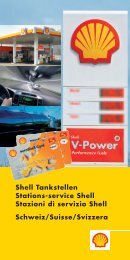
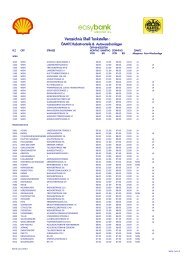
![Download Shell AutoGas Stationen [Stand: Januar 2013] (PDF](https://img.yumpu.com/9982753/1/190x245/download-shell-autogas-stationen-stand-januar-2013-pdf.jpg?quality=85)
